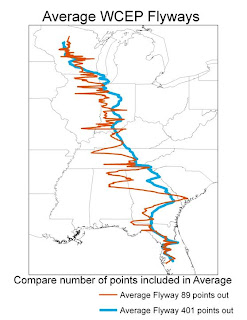Sunday, November 13, 2011
Migration Analysis
Before I left on migration, I managed to squeeze in a quick presentation on all of the migration analysis work I've been doing. Essentially, here's what I found so far:
All of the whooping crane migration data looks like this. Note that it is roughly 36,000 data points over 10 years in the fall through spring migration months.
Based on a paper by Tacha, et. al. I created an average fly line using all the points. Well, actually I made two, the first fly line (orange) was waaay too jagged for my purposes. The second (blue), using almost twice as many data points for the average was smoother and more suitable to my purpose.
This was my final choice for the fly line.
After that, I wanted to find what percentage of the population was using land near the average fly line. Are all of the birds using this basic route? are half the birds using this route?
So I calculated what percent of the birds were within a certain distance from the line. It looks like this.
This says that 75% of the birds over 10 years of sightings are within 10 miles of the average fly line! This seems unbelievably small given what I know about this population. So I wanted to find out if maybe there was a heavy skew at both ends of the line. There are many sightings of birds on home ranges before they leave for migration and after they end migration in this data set.
In an effort to remove the skew, I didn't address Wisconsin and Florida at all in my next set of calculations:
As you can see, there's a drastic difference between the first set of calculations and the second. This new graph shows that along the flyway, 75% of the cranes are within a 150 mile corridor of the average fly line. If the first set of calculations was too good to be true, then this set of calculations is almost too big to be of any use. How are we supposed to tell Indiana that in order to take local action that would protect the the whooping cranes, they have to cover the ENTIRE STATE? most of the cranes don't fly through the North Eastern quadrant of the state, but you wouldn't know that from this map.
As you can see, I still have some work to do. I would like to include Wisconsin and Florida without skewing the data, and I would like to have a solid product to leave the Crane Foundation with when my internship is through.
I hope I didn't bore you with too much science. Here are some pretty crane flight pictures that I included in my presentation. These are all provided by Eva.
Subscribe to:
Post Comments (Atom)











No comments:
Post a Comment